In general people with diabetes face greater risks of complications when dealing with viral infections like flu, and that is likely to be true with COVID-19.
Here’s what you should know. | Read more.

In general people with diabetes face greater risks of complications when dealing with viral infections like flu, and that is likely to be true with COVID-19.
Here’s what you should know. | Read more.

When you’re diagnosed with type 2 diabetes or prediabetes, it’s easy to start imagining all the foods you’ll “never” be able to eat again. After all, you’ve heard that diet and weight loss are important for managing type 2 diabetes, so it’s natural to assume that means people with diabetes have to follow a strict diet.
It’s true that lifestyle changes like eating behaviors can help manage or prevent type 2 diabetes, but more and more research shows that “dieting” may not be the best strategy.
First of all, what do we mean by “diet”? Technically, a “diet” is just the foods that you typically eat every day. But most people think of a diet as a structured eating program that restricts certain foods or nutrients. And often when people “go on a diet” it’s considered a temporary change, usually with the goal of losing weight quickly.
Most people assume that dieting is the best way to lose weight. You probably know someone (maybe yourself) who “successfully” lost a lot of weight by going on a diet. But did the weight stay off?
Probably not—research shows that 95-98% of dieters regain that weight and up to two thirds regain even more. So it seems like dieting may not be the best strategy for long-term weight loss for most people.
Even worse, chronic dieting can cause stress and anxiety around eating, and even lead to disordered eating behaviors. People with diabetes may be uniquely at risk—research shows that “disordered eating behaviors may affect up to 40% of patients with type 2 diabetes mellitus.”
The “diet mindset” is believing in external rules about what you should and shouldn’t eat. It can create feelings of shame, guilt, anxiety, and deprivation, and make it harder to listen to your body’s internal signals of hunger, fullness, and satisfaction.
Try some of these strategies for getting out of the “diet mindset”:
Instead of classifying foods as “good” and “bad”: Think of foods as neutral. Eating a certain way does not make you a better or worse person, and there is no reason to feel shame or guilt for eating foods that you enjoy.
Instead of following rules about what you “can” and “can’t” eat: Learn how your body responds to different foods, and understand why you’re better off avoiding certain foods. Instead of telling yourself “I can’t eat this,” think “my blood glucose doesn’t respond as well to this food.”
Instead of counting calories: Let your body’s hunger and fullness cues guide how much you eat. Eat slowly and savor your food. Pause mid-meal to check your hunger level. Eat until you are comfortably satisfied, not until you are uncomfortably full.
Instead of measuring success based on numbers, such as body weight or A1C: Look for other victories like better mood, increased energy, better mobility, and improved sleep. Celebrate positive behavior changes.
Instead of letting eating feel like a burden: Practice mindful eating techniques such as eating slowly and savoring the taste, texture and aroma of the foods you are eating. This will allow you to regain the pleasure of food and have full satisfaction in your meals.
Instead of denying your cravings: Understand your cravings. Check your blood glucose when cravings hit: if it’s low, this may be a “physiological craving”—your body is telling you that it needs food. If is normal or high, it may be an “emotional craving.” Learn what triggers emotional cravings and develop strategies to manage them.
Instead of exercising to burn calories: Find ways to be active that feel good and that you genuinely enjoy. Think of physical activity as a celebration of the things your body can do, instead of punishment for the things it can’t do.
Bonnie R. Giller is a Registered Dietitian Nutritionist, Certified Diabetes Educator and Certified Intuitive Eating Counselor. Learn more about Bonnie at BRGHealth.com. Find more Intuitive Eating tips on her blog.

If diet is so important for managing diabetes, surely there is one perfect diet that everyone with diabetes should follow, right? The media, the internet, your Facebook feed, and even your Aunt Judy all have opinions about the correct diet for diabetes. So, what’s the answer? Every year, U.S. News surveys popular diets and eating patterns—including keto, Mediterranean, vegan, DASH, and others—and then reviews the scientific evidence to compile their annual list of best diets for diabetes. This year’s results may just surprise you.
Every year, U.S. News gathers a panel of experts to review and rank the best “diets” for overall health, weight loss, heart health, diabetes, and other categories.
The panel reviews the most up-to-date research and evidence on each diet and its claimed health benefits. They also consider how easy the diet is for people to follow and stick to, and if health benefits, such as weight loss, last in the long term.
Topping the list of “Best Diets for Diabetes” is the Mediterranean diet (this diet was also ranked #1 in “Best Overall”). Next is a four-way tie for second place between DASH, Flexitarian, Mayo Clinic, and Vegan diets.
1. They’re not really “diets.”
At least not in the modern sense. These diets are not considered temporary regimens to “detox,” “reset,” or reach a certain goal quickly. They’re more like eating patterns that are intended to be permanent.
With the exception of vegan, none of the top-ranked diets cut out certain foods or nutrients, or have strict rules to follow. And none of them require you to count calories or carbs.
2. They focus on plant foods.
All of these patterns encourage eating more plant foods like vegetables, fruits, whole grains, beans, and legumes (the vegan diet goes even further by only allowing plant-based foods—it eliminates all animal products, including meat, poultry, fish, eggs, and dairy foods).
Research overwhelmingly supports the benefits of eating more plant-based foods. Plant foods are packed with vitamins, minerals, and antioxidants that are important for general health. They’re also the best source for fiber, which helps manage blood glucose.
Essentially, plants are nutrient-dense and low in calories, giving you a lot of bang for your buck!
3. They don’t focus on restricting carbs.
You may notice that the list does not include any diets focused on restricting carbs like keto or Atkins. While research shows that reducing carb intake can help manage blood glucose, there’s not enough evidence to say that people with diabetes need to cut out all carbs.
The bigger issue is that very low carb diets can also be hard to stick with in the long run. It may be easier to start by focusing on the quality of carbs, monitoring your portions, and following a flexible healthy eating pattern for long-term benefits.
4. They’re not “fads.”
The most successful patterns have all been around for a long time. The Mediterranean diet may seem like a new fad, but it’s based on the way people in the Mediterranean region have been eating for centuries.
The “Flexitarian diet” may also sound fancy and new, but many people already eat this way, whether they’re trying to or not.
Veganism has also been around for a long time, and some people choose to eat this way for ethical or environmental reasons as well as health reasons.
5. They’re backed by science.
All of the top-ranked diets have been extensively researched and have a mountain of scientific evidence backing them up. DASH and Mayo clinic diets were developed by respected, evidence-based institutions.
Mediterranean, vegan, and “flexitarian” eating patterns have been around for a long time, but they are getting trendier as more and more research shows their health benefits.
It’s important to note that none of these eating patterns are particularly “better” than the others. With a four-way tie for second place, and a three-way tie for third place, there are eight “Top 3” diets!
All of these eating patterns include basic principles of healthy eating, so any one of them can help you manage or prevent type 2 diabetes.
The best diet for you is going to be the one that fits best with your lifestyle and preferences, and that you’re most likely to stick with long-term.
You don’t have to follow a certain “diet” to manage diabetes. Work towards a healthy eating pattern that fits your lifestyle and preferences. Here are some tips to help you get started:
Remember, any time that you’re making changes to your medication, eating, or exercise be sure to have a conversation with your health care team. A Registered Dietitian Nutritionist (RDN), or a Certified Diabetes Care and Education Specialist (CDE or CDCES) can help you develop a healthy eating plan that fits your needs.

Diabetes is a condition that affects the way the body processes blood glucose. High blood glucose levels (also known as hyperglycemia) can damage your body in different ways and make you more likely to develop heart disease or stroke. The good news is that you can help manage both—your cardiovascular risk and your diabetes—by eating smart and making healthy lifestyle choices.
If you have diabetes or prediabetes, you may be wondering what, when, and how much you should eat. It may surprise you that there is no “diabetes diet” or perfect amount of nutrients (protein, fat, or even carbohydrates) that’s right for every person with diabetes.
Your eating plan—what, when, and how much you eat—should be personalized to meet your needs. A Registered Dietitian Nutritionist (RDN) or Certified Diabetes Educator (CDE) can help you create an eating plan that fits your lifestyle, eating preferences, health goals, and budget. Ask your primary health care provider if you need a referral.
You don’t need to follow a specific diet to manage diabetes and reduce your risk of heart disease. But there are several basic recommendations to keep in mind as you make your daily food choices:
Eat a variety of vegetables. Nonstarchy vegetables (such as broccoli, cauliflower, spinach, and green beans) are low in calories and carbohydrates, and high in fiber, vitamins, and minerals that are essential to good health. Aim to fill half your plate with nonstarchy vegetables at meals.
Choose fiber-rich whole grains, such as brown rice, oats, quinoa, barley, and breads and pastas made with 100% whole wheat. Try to eat fewer foods made with refined grains, such as white bread, white pastas, and many baked goods.
Choose lean proteins, such as poultry without the skin and extra-lean cuts of meat. Look for healthy ways to prepare protein options, such as broiling, baking, grilling, roasting, and searing.
Eat fish twice a week, preferably those high in omega-3 fatty acids, such as salmon, lake trout, albacore tuna, sardines, and herring.
Include beans, legumes, nuts, and seeds. These foods are high in fiber and a good source of plant proteins and heart-healthy fats.
Eat a variety of fruit. Choose fresh, frozen, or canned fruit. Whole fruits are preferred over fruit juices because they are higher in fiber and are more filling.
Choose low-fat or fat-free dairy products, such as skim or 1% milk, non-fat yogurts, low-fat cream cheese or sour cream, and reduced fat cheeses.
Limit added sugars. Added sugars are sweeteners—such as sugar, corn syrup, brown sugar, honey, and maple syrup—that are added to foods during processing. Check the nutrition facts label to see how much added sugar is included in a food product.
Choose foods with less sodium by using whole foods and looking for products that are lower in sodium (check the nutrition facts panel). Use little or no salt when preparing foods, and don’t add salt to food at the table.
Not only is it important to eat smart, you should also maintain a healthy lifestyle to best manage your diabetes and heart health.
Move more, sit less. Aim for 150 minutes each week of mild cardio exercise like walking, or 75 minutes of intense cardio exercise like jogging or biking (or a combination of both). Break up long bouts of sitting by getting up every hour and walking around for a few minutes.
Maintain a healthy weight. Talk to your health care provider about what a healthy weight is for you. You can work to create an individualized plan to achieve or maintain your healthy weight.
Live tobacco and vape free. Don’t smoke, vape, or use tobacco or nicotine products. Avoid secondhand smoke or vapor.
Drink alcohol in moderation—or not at all. If you drink, do so in moderation. That means no more than one drink per day for women, and no more than 2 drinks per day for men.
Be well. Beyond eating smart and being active, staying healthy includes getting enough sleep, managing stress, keeping your mind and boy fit, and connecting socially.
Schedule regular medical checkups. Make an appointment with your health care provider to discuss your personal risk for heart disease and stroke.
For more information and resources on diabetes and heart disease, visit www.KnowDiabetesByHeart.org.
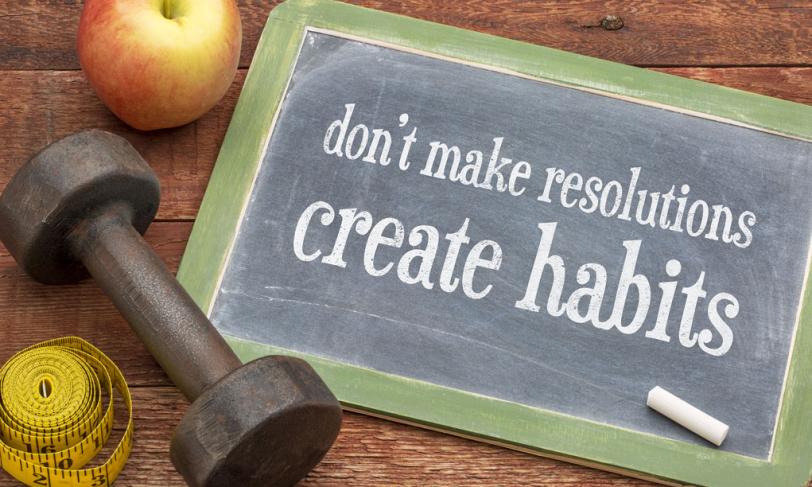
A lot of New Year’s resolutions sound like great ideas. They seem like the solutions to so many problems. That strict diet that you start on January 1st or next Monday will better your blood glucose, slim you down, control your cholesterol, get you off blood pressure medications and so much more. And your new gym membership will do the same.
Unfortunately, resolutions rarely last very long or give us that huge impact we’re after. Resolutions tend to be grandiose and eventually feel like punishment. If you want to make changes this year, skip the resolutions and commit to a few small behavioral goals.
Small behavioral goals are likely to become habits. A small goal such as eating 3 servings of non-starchy vegetables is much more realistic than overhauling your diet completely. By planning your steps to eat your vegetable servings day after day, you’ll soon have a good habit to rely on.
They spur us on to bigger things. Success motivates us to pursue more success. Start small to get the jumpstart that leads to bigger goals and bigger results.
They aren’t so black and white. Once those big resolutions are broken, that’s usually the end of them. But small goals aren’t simply a function of our resolve to do something difficult. Small goals allow you to focus on the process of meeting your goal even more than the outcome of meeting it.
Using the example of eating 3 servings of vegetables every day, you’ll learn what it takes to prepare them, schedule time to shop for them, pair them with other foods and so many more skills that you can use for other, bigger goals.
If getting regular exercise is your goal, ask yourself why. Write down a list of whys. Is it a path to better blood glucose management? Better sleep, more energy, greater heart health, more confidence? Pick a goal that you want very badly. Avoid picking one just because you should want it.
Every tough change has at least one negative associated with it. Otherwise, you would have already done it. Does meeting your exercise goal mean that you have to wake up earlier, pay for childcare or eat dinner at a different hour?
Use the following to write a more detailed plan:
This is easy to ignore, but critical to do. It’s not enough to say that you’ll exercise 5 mornings this week. You also need to identify what it will take to be successful. Do you need buy new walking shoes, get out of bed a few minutes earlier, arrange for your spouse to look after the kids?
There are very few difficult tasks that we can accomplish entirely on our own. It’s okay to ask someone to watch your kids, unload the dishwasher, run an errand or do something else to free you up to take a walk or try out some new recipes.
Not being 100% successful doesn’t mean that you were 100% unsuccessful. Take pleasure in what you did accomplish. And look critically at your efforts and outcomes. What worked out well and what didn’t go so well? What did you learn? What part did you like? Use that information to tweak your goal and your plan to meet it next week.
Cheers to a happy, healthy 2020!
Jill Weisenberger, MS, RDN, CDE, CHWC, FAND is the author Prediabetes: A Complete Guide and Diabetes Weight Loss – Week by Week. Find more food and nutrition advice from Jill at jillweisenberger.com/blog
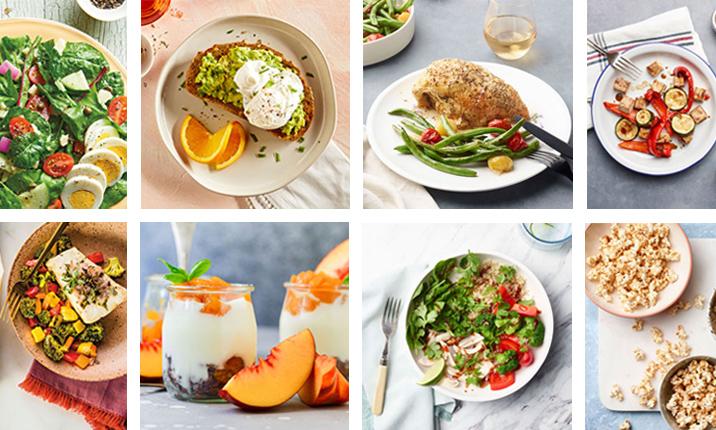
Do you have a resolution to eat healthier this new year? Cooking more meals at home is a great way to start, but it can be challenging to plan, shop, and prepare meals every week. To help, we’ve come up with a clean and simple meal plan of recipes featuring natural, healthy, whole foods. This meal plan is low in sodium, has no added sugar, and provides balanced meals loaded with vegetables, lean protein, and whole grains.
You can fit these recipes into your weekly meal plan in whatever way works best for you. Use the interactive Meal Planner on Diabetes Food Hub to plan out your week. Once you have created your free account, you can save recipes, then drag-and-drop them into your meal plan.
Click here for more tips on how to use Diabetes Food Hub

Make this dinner early in the week and make extra chicken for leftovers (you can easily double the recipe). You could also add a whole grain to this meal, like brown rice or Cilantro Lime Quinoa.
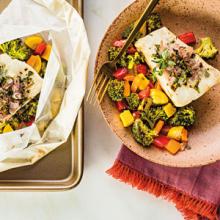
The sweet potatoes and the fish pouches cook at the same temperature, so you can bake everything at once. Start by preparing the Sweet Potato Masala; you can prepare and bake the fish and vegetable pouches while the sweet potatoes are roasting.

This “stir-fry” is cooked in a sheet pan for an even easier “hands-off” dinner. This calls for zucchini and red pepper, but you could use any nonstarchy vegetables, fresh or frozen.

To make this bowl, you can use leftover chicken, quinoa, and vegetables from any of the dinner meals. Bring it all together with greens and a drizzle of homemade Fruit-Sweetened BBQ Sauce.
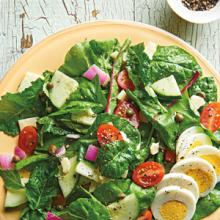
This filling salad is a meal all on its own! If you have more chicken left over, you could add it to this salad for more protein (or instead of the hard-boiled egg).

Instead of store-bought yogurt containers that are loaded with added sugar, try this homemade parfait! Plain yogurt is sweetened with a fruit-based jam and fresh or frozen peach slices. You can prepare the jars ahead of time, but add the Homemade Fruit-Sweetened Granola just before eating.
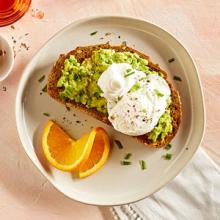
This recipe boasts whole grains, healthy fats, and protein that will keep you full until lunch. You can poach the eggs in the microwave for a simple, yet perfectly cooked egg, or top the toast with a sliced hard-boiled egg that was made ahead of time.
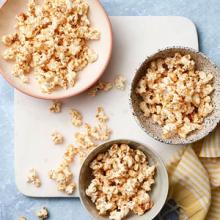
Instead of piling on salt and butter, this popcorn is flavored with Fruit-Sweetened BBQ Sauce and smoked paprika. If you don’t have avocado or sunflower oil, you could use canola oil. Or, if you have an air popper, you can pop the corn without any oil.

Frozen bananas provide a creamy texture and sweet flavor in this dairy-free “nice cream.” Cacao nibs add a nice crunch, but it you can’t find them in the store, you could use chocolate chips, or just leave them out.

Like these recipes? Find more clean and simple recipes in our new cookbook, The Clean & Simple Diabetes Cookbook by Jackie Newgent, RDN, CDN. Designed with simplicity in mind, each recipe in this book uses no more than 7 ingredients and needs only 15 minutes or less of prep time.
Check your pantry before you go to the grocery to see what you already have on hand, particularly the “pantry items” section. The grocery list includes the quantity you need of each item, so you can tell if you have enough or need to buy more.
You’ll need about 3–4 lbs total of nonstarchy vegetables for the Seasonal Baked Whitefish Pouch and Leftover BBQ Bowl. You can use whatever is in season or on sale, or your favorite non-starchy vegetables. Frozen vegetables are also an option.
To make things easier during mealtime, there are several things in this meal plan that you can make and do ahead of time:
Make the Fruit-Sweetened BBQ Sauce: This sauce takes just 5 minutes to prepare and is a healthier option than store-bought sauce. Prepare it ahead of time and store it in the fridge for up to one week. You’ll use this sauce on the Leftover BBQ Bowl and the BBQ Popcorn.
Make the Homemade Granola: You’ll use this granola in the Peachy Yogurt & Granola Jars. Store in an airtight container in your cabinet for up to one week.
Make the Cilantro Lime Quinoa: If you have time over the weekend, go ahead and prepare the cilantro lime quinoa. Simply reheat in the microwave to serve with the Sheet Pan Stir Fry. Use leftover quinoa for the Leftovers BBQ Bowl. You could also make a double batch and serve this quinoa with the Herbs de Provence Chicken.
Prepare the Powerhouse Salad: You can easily prepare this salad ahead of time, just store the dressing separately. Combine the vinegar, oil, capers, oregano, and salt in a small sealed container. Shake vigorously and drizzle over the salad just before eating. This recipe makes one serving, but you could easily prepare more than one—just make sure you buy enough greens!
Make hard-boiled eggs: The Powerhouse Salad calls for 1 hard-boiled egg. Make more if you plan to make more than one salad for the week, or make extra for a quick, protein-packed snack. You could also use hard-boiled eggs instead of poached eggs in the Egg & Avocado Toasts for an even quicker breakfast.
Prepare Peachy Yogurt & Granola Jars: The recipe makes two jars, but you could prepare as many as you want ahead of time for a grab-and-go breakfast. If you’re preparing ahead of time, don’t add the granola; store it separately and add just before eating so it stays crunchy.

It seems every year there’s a new fad diet that everyone is talking about. But recently non-diet approaches like “Intuitive Eating” or “Mindful Eating” have gained in popularity. What do these terms mean, and how do they work?
Intuitive Eating is a “non-diet” approach to changing eating behaviors. It focuses on tuning into your body’s internal signals of hunger, fullness, and satisfaction as your guide to eating, instead of following external rules and restrictions on what, when, and how much to eat. This is different than Mindful Eating, which is more about the “how” of eating and being present at the table in a non-judgmental way.
Intuitive Eating is not a weight loss plan. Goals of Intuitive Eating may focus on mental health, emotional well-being, and other markers of physical health, but not on weight and body mass index (BMI).
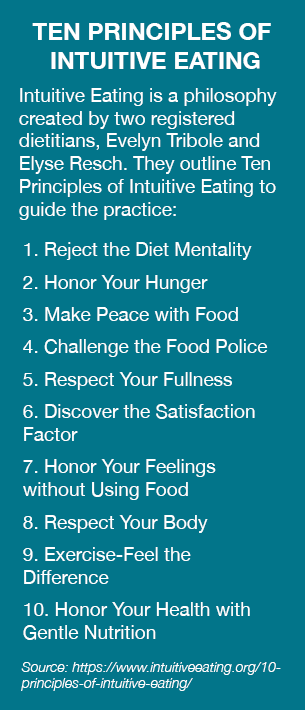
Ultimately, Intuitive Eating aims to help you rebuild trust in yourself and your body and enjoy a new relationship with food.
Intuitive Eating can be helpful for “chronic dieters”—people who go on and off restrictive diets—or people who struggle with anxiety, guilt, or other negative feelings about food and eating.
That said, anyone can practice the principles of Intuitive Eating, even those with diabetes or other medical conditions. While some medical conditions, like allergies, may require restricting or eliminating certain foods or nutrients, some of the principles of Intuitive Eating can still be used in these situations to reduce food anxiety, keep eating pleasurable, and improve body image and self-esteem.
As always, talk with your health care team about your personalized nutrition plan.
Research on Intuitive Eating is still growing. Studies so far have associated Intuitive Eating with lower triglycerides, higher HDL cholesterol, lower blood glucose levels, and a lower BMI.
Research in people with diabetes is limited, but some early studies suggest that Intuitive Eating could help with blood glucose management as well.
The biggest benefits of Intuitive Eating may be related to mental health and wellbeing, especially for women. By removing the stress of following strict diets, Intuitive Eating can lead to higher self-esteem, less anxiety, depression and emotional eating, and improved body image.
Intuitive Eating removes food restrictions and allows you to be in the “driver’s seat” about your food choices. For some people, this may be freeing and relieve the pressure to follow certain rules. But others may feel lost without the guidance of a more structured eating plan.
Intuitive Eating may be somewhat controversial since it goes against conventional ideas of diet and weight loss as keys to improving health. You may need to find a Certified Intuitive Eating Counselor or other mental health care provider for additional support.
With diabetes, it’s still important to be aware of what you’re eating and monitor how different foods impact blood glucose.
But Intuitive Eating can help reduce anxiety and guilt around food choices by monitoring blood glucose and adjusting eating behaviors in a non-judgmental way. For example, instead of thinking “I can’t eat this,” an intuitive eater will think “my blood glucose doesn’t respond as well to this food” and adjust food choices as needed.
Like any lifestyle change, Intuitive Eating takes practice, commitment, and support. If you think Intuitive Eating may be right for you, consider seeing a Certified Intuitive Eating Counselor and Registered Dietitian Nutritionist. Search the Counselor Directory here.
Bonnie R. Giller is a Registered Dietitian Nutritionist, Certified Diabetes Educator and Certified Intuitive Eating Counselor. Learn more about Bonnie at BRGHealth.com. Find more Intuitive Eating tips on her blog.

To celebrate the release of our new cookbook, The Instant Pot Diabetes Cookbook, we held a recipe contest to “instant-pot-ize” your favorite family recipes and make them diabetes- and instant-pot friendly! Cookbook author Nancy S. Hughes tested dozens of recipes, and ultimately chose one lucky winner and four runners up. Read on to see the winning recipes!
To make the recipes more diabetes friendly, Hughes added extra vegetables, chose lean proteins, and kept the sodium in check by using low sodium ingredients. Instead of relying on salt for flavor, she added lots of herbs and spices to create tasty, healthy dishes.

Looking for more diabetes-friendly Instant Pot recipes? Check out The Instant Pot Diabetes Cookbook and our Instant Pot recipe round up!
And the winner is…
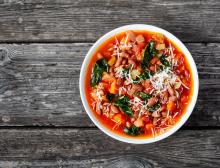
This winning soup boasts a wide variety of colorful vegetables. It’s super easy to prepare in the Instant Pot, and budget-friendly, too! It makes a large batch, but leftovers can be frozen in individual serving containers for a quick lunch or dinner throughout the busy holiday season.

That classic fall spice blend of cinnamon, cloves, and nutmeg turn ordinary chili into your new favorite recipe for fall!
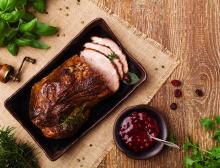
This pork roast is a celebration of winter with pecans, cranberries, citrus, and spice. Make it the star of your Christmas dinner!

This Cajun classic gets a healthy upgrade with a mix of brown rice and quinoa and loads of extra vegetables.

The Instant Pot is perfect for chilis and stews and picking just one chili for the contest was too hard. So here is another go-to cold-weather recipe! This dish gets its name from the combination of black beans and white beans, which each add their own flavor and texture.

As we wrap up 2019, the Diabetes Food Hub team looked back and reviewed some of the most popular recipes this past year as determined by you, our visitors. Favorites include heart-healthy Mediterranean dishes, hearty breakfast pancakes, and a handful of air fryer and Instant Pot recipes. Whatever you’re looking for, we’re sure you’ll find some tried and true recipes.
For our first full year of the Diabetes Food Hub, we saw a number of cooking and recipe trends that ended up on this list. First, we had no idea just how popular breakfast recipes would be. Second, a lot of people have Instant Pots and air fryers and are looking for appliance-friendly recipes. And finally, there’s a neverending demand for the basics—healthy and diabetes-friendly versions of classic recipes. Fortunately, Diabetes Food Hub had plenty of each.
So without further ado, here are the Top 20 Recipes of 2019.

Did we mention that breakfast was a popular category? This low-carb breakfast made with turkey sausage and turkey bacon comes from our friends at the Mr. Food Test Kitchen, and it was our most “liked” recipe of 2019. Freeze the individual cups after they’re prepared for a grab-and-go breakfast that can be reheated at home or in the office!

Is it possible to make fried chicken diabetes-friendly? Absolutely! Especially if you have an air fryer. This small appliance “fries” food with hot circulating air, drastically cutting the fat and calories from traditional deep frying. This recipe creates juicy, flavorful fried chicken by marinating the chicken in buttermilk, then coating it in a cornflake crust.

Smoothies are a popular category on Diabetes Food Hub, and it’s easy to see why. As a meal-replacement, a snack, or a quick and easy breakfast, smoothies can be very versatile. That said, they can also be an easy way to consume added sugars, so try not to add sweeteners beyond fruit. Get creative and mix up the types of fruits in this smoothie to keep things fresh.

Diabetes-friendly pancakes seemed like an impossible quest until the authors of The Diabetes Cookbook gave us this recipe. Finely chopped oats can make an easy, whole-grain alternative to flour in many recipes, including these pancakes. Skip the maple syrup, and try our recipe for Blueberry Sauce for a low-sugar topping!

These brownies are made with a surprising ingredient that gives them a nutrition kick and fiber boost that you won’t find in regular brownies. Perfect for those managing Celiac or a gluten intolerance, these brownies really shine with a fruit topping, such as raspberries or blackberries.

Instead of ordering takeout, make a healthier version of this classic Thai soup at home in your Instant Pot! This vegan soup is loaded with vegetables and gets it’s rich creaminess from coconut milk. Best of all, the Instant Pot speeds up the cooking time, so it’s ready in less than 30 minutes, but tastes like it’s been cooking all day!
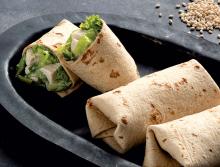
If you are tired of the same boring sandwich for lunch, try this restaurant-style wrap, featured in The Diabetes Cookbook. This is perfect if you find yourself with leftover chicken breast. If not, use cooked rotisserie chicken from your grocery store to save yourself a little time.

A recipe doesn’t have to be complicated to be delicious. This chicken dish was a Diabetes Food Hub favorite in 2019, perhaps because it is perfect for a busy weeknight dinner. Just remember to marinade the chicken the night before for extra flavor.

Need a healthy snack for your holiday road trip? This popular recipe is a simple treat—and much better for you than any processed snack that you get at a gas station. It will satisfy your sweet tooth while also packing in a lot of fiber.

Here’s another diabetes-friendly version of a classic recipe—this time the comfort food favorite, beef stroganoff. Using whole grain egg noodles ups the fiber content, and the fat-free sour cream cuts calories. Looking to save yourself some prep time? Buy presliced mushrooms to cut down on time at the cutting board.

Healthy eating can be done on a budget and this dinner proves it! Chicken thighs are less expensive than chicken breasts, and have a more savory flavor that’s perfect for braising. This makes a tasty, low-carb, budget-friendly meal.
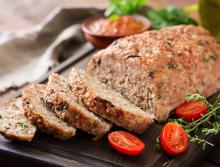
Does it get any more classic than meatloaf? Diabetes Food Hub visitors loved this herb-filled take on a family favorite in 2019. By using oatmeal in place of breadcrumbs you get more fiber than in the traditional version.
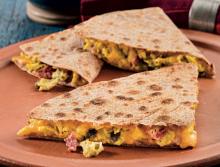
Fluffy eggs and spicy chiles folded into a tortilla with rich melted cheese makes breakfast a pleasure! You can use a variety of cheeses such as asadero, Monterey jack, and white cheddar. Looking for even more Tex-Mex flavor? Make a chorizo quesadilla by swapping out the bacon for 4 oz cooked beef or pork chorizo.

This recipe comes from Robyn Webb’s bestselling Diabetes Comfort Food Cookbook. According to Webb, the secret to makeing this recipe diabetes-friendly is using butter-flavored spray and phyllo dough to slash the saturated fat and calories found in a typical pie crust topping (without sacrificing any flavor)!

Making dessert for the holidays or another special occasion? This satisfying 2019 user-favorite dessert can be prepared ahead of time and refrigerated. Just before serving, portion it out and top with the whipped topping. The results are beautiful, delicious, and guaranteed to impress.

A popular request in 2019? More recipes that used herbs and spices to boost flavors without adding salt, fat, carbs, and calories. The star of this meal is the low-sodium herb blend that you can make in large batches and use to meat, fish, and even vegetables. Low-sodium eating does not have to be bland and boring. This recipe proves it.
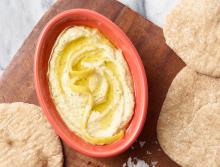
The research is in—numerous studies agree that the Mediterranean diet is one of the healthiest eating patterns in the world. This recipe can be made in a flash, and it combines all the bright flavors of Greece. Diabetes Food Hub visitors couldn’t get enough!
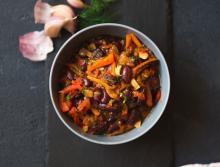
One-pot dishes are always popular—easy to make and a breeze to clean up—and this Veggie Chili recipe proved the trend wasn’t fading anytime soon. The beans and veggies in this dish make it a great source of fiber with 10 grams per cup. The recipe makes 8 servings, so you’ll have plenty leftover for lunch!

While this is technically a breakfast recipe (did we mention breakfast recipes are popular?), it can easily be served any time of day. The savory blend of roasted tomatoes and perfecty broiled eggs is delicious, but the real story is how easy and inexpensive it is to prepare. If you can get your hands on fresh heirloom tomatoes, this recipe really shines.

Seafood is a true superfood: it’s packed with healthy fats, high in protein, and the foundation of healthy eating patterns like the Mediterranean diet. Out of the hundreds of seafood recipes on Diabetes Food Hub, this one stood out as our most popular of 2019. With just a few ingredients, you can have a beautiful, heart healthy meal on the table in about 15 minutes.

Who doesn’t love tacos? Closing out our top 20 list is a Tex-Mex classic. Break out your slow cooker or Instant Pot, prep in the morning, and come home to tender braised taco meat when you walk through the door in the evening. Flank steak is a leaner cut of red meat, which makes it very heart healthy and great for a diabetes meal plan.
We’ve been amazed at the response to our Diabetes Food Hub and have been thrilled to see the audience for the site grow leaps and bounds over the past year. In 2020, we’ll be making the site even better by adding hundreds of new recipes and adding even more interactive meal planning and shopping features. We hope you’ll stop back by to see all that we have in store. In the meantime, thank you for making Diabetes Food Hub the number one diabetes food and cooking website on the web!

Stumped on what to cook for Thanksgiving? We’ve got you covered! This all-in-one handbook has everything you need to prepare a diabetes-friendly Thanksgiving feast on a budget, including recipes, a grocery list, a game-plan, tips for building a healthier Thanksgiving plate, and ideas for leftovers. Our healthier Thanksgiving has one-third the calories, carbs, and fat of a traditional Thanksgiving meal, and at less than $10 a serving, it’s easy on your budget, too.
Our menu includes healthier versions of Thanksgiving classics. All of the recipes have been modified to make ten servings—perfect for a crowd, or a small family gathering with plenty of leftovers.
Save time (and calories!) by roasting only the turkey breast instead of a whole turkey. The breast meat has less fat than the dark meat, which cuts down on saturated fat.
No need to cut out stuffing for your holiday meal. Enjoy this bread stuffing and still keep your carbohydrate count down. The vegetables, fresh herbs, and apple add flavor and help fill out the serving.
Mashed potatoes are a Thanksgiving staple. The potato is the star of this comfort food side dish, but a nonstarchy vegetable plays a surprising supporting role. The result is light, luscious, and diabetes-friendly.
Here’s a lighter take on a traditional creamy green bean casserole. This recipe has only 4 grams of carbohydrates per serving. The hazelnuts give a crunchy texture and the dried cranberries add a colorful touch.
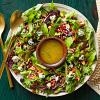
Blue cheese, pomegranates, and hazelnuts add interesting flavor and crunch to this salad, making it deliciously easy to add more vegetables to your holiday plate. Adding a salad to your Thanksgiving menu makes it easier to fill half your plate with nonstarchy vegetables.

No one will ever know this simple treat is diabetes-friendly! You can serve these mini tarts and impress your guests with this low-carb dessert. But don’t let these low-calorie treats fool you, they still pack in tons of pumpkin flavor.
This list contains not only all of the ingredients needed, but also the amounts you will need for the recipe. That way, if you already have some of the ingredients on hand, you’ll be able to tell if you have enough or need to buy more. This is especially helpful for spices and bottled sauces.
In addition, the shopping list is organized according to supermarket department. With large supermarkets, it can be annoying to realize that you forgot something in the dairy department when you’re in the produce section. This list should help, and may even cut down the amount of time you spend in the market.
The cost for this meal is $8.90 per person. The estimated prices of ingredients are based on national food store prices and will vary according to area. This number will give you an idea of what the meal will cost. Also, keep an eye out for sales!
Join Diabetes Food Hub for free to unlock our meal planner and grocery list tools!
Preparing a Thanksgiving feast may seem stressful, but there’s plenty you can do before the big day to set yourself up for success. Making dishes ahead of time helps spread the work over more than just one day, and can free up precious stove and oven space. Here is a step-by-step game plan:
Weekend before Thanksgiving
Monday
Tuesday
Wednesday
Thursday
3 hours before serving
2 1/2-hours before serving
2 hours before serving
30 minutes before serving
20 minutes before serving
After main course
By choosing healthier recipes, loading up on nonstarchy vegetables, and keeping portion sizes in check, our Thanksgiving plate has about one-third of the calories, carbs, and fat of a traditional Thanksgiving meal!
Our Diabetes-Friendly Meal vs. Traditional Thanksgiving Meal*
*Traditional Thanksgiving meal consisting of turkey w/ gravy, mashed potatoes, green bean casserole, stuffing, sweet potato casserole, cranberry sauce, dinner roll, pumpkin pie
To build a healthier Thanksgiving plate, use the plate method:
Related: Tips for Surviving You First Holiday Season with Diabetes
Even with the smaller breast cut in our turkey recipe, there’s going to be plenty left over. Try these recipes to get more mileage out of your Thanksgiving centerpiece.
Warm up with this hearty, broth-based soup. You can even make your own turkey stock from the turkey bones for an rich flavored soup.
Try this light sandwich instead of the traditional leftover turkey sandwich.